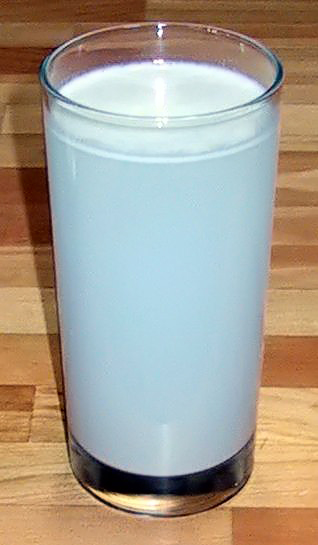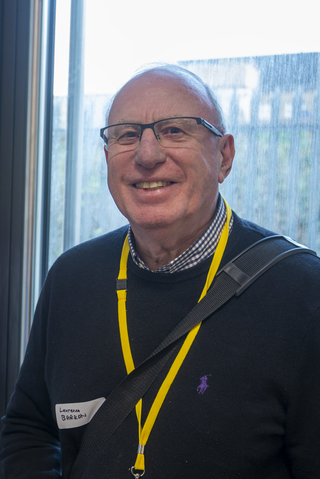Related Research Articles

A colloid is a mixture in which one substance consisting of microscopically dispersed insoluble particles is suspended throughout another substance. Some definitions specify that the particles must be dispersed in a liquid, while others extend the definition to include substances like aerosols and gels. The term colloidal suspension refers unambiguously to the overall mixture. A colloid has a dispersed phase and a continuous phase. The dispersed phase particles have a diameter of approximately 1 nanometre to 1 micrometre.

In chemistry, a suspension is a heterogeneous mixture of a fluid that contains solid particles sufficiently large for sedimentation. The particles may be visible to the naked eye, usually must be larger than one micrometer, and will eventually settle, although the mixture is only classified as a suspension when and while the particles have not settled out.
Sedimentation equilibrium in a suspension of different particles, such as molecules, exists when the rate of transport of each material in any one direction due to sedimentation equals the rate of transport in the opposite direction due to diffusion. Sedimentation is due to an external force, such as gravity or centrifugal force in a centrifuge.

The Tyndall effect is light scattering by particles in a colloid or in a very fine suspension. Also known as Tyndall scattering, it is similar to Rayleigh scattering, in that the intensity of the scattered light is inversely proportional to the fourth power of the wavelength, so blue light is scattered much more strongly than red light. An example in everyday life is the blue colour sometimes seen in the smoke emitted by motorcycles, in particular two-stroke machines where the burnt engine oil provides these particles.
In materials science, the sol–gel process is a method for producing solid materials from small molecules. The method is used for the fabrication of metal oxides, especially the oxides of silicon (Si) and titanium (Ti). The process involves conversion of monomers into a colloidal solution (sol) that acts as the precursor for an integrated network of either discrete particles or network polymers. Typical precursors are metal alkoxides. Sol-gel process is used to produce ceramic nanoparticles.

Particle agglomeration refers to the formation of assemblages in a suspension and represents a mechanism leading to the functional destabilization of colloidal systems. During this process, particles dispersed in the liquid phase stick to each other, and spontaneously form irregular particle assemblages, flocs, or agglomerates. This phenomenon is also referred to as coagulation or flocculation and such a suspension is also called unstable. Particle agglomeration can be induced by adding salts or other chemicals referred to as coagulant or flocculant.

Dynamic light scattering (DLS) is a technique in physics that can be used to determine the size distribution profile of small particles in suspension or polymers in solution. In the scope of DLS, temporal fluctuations are usually analyzed using the intensity or photon auto-correlation function. In the time domain analysis, the autocorrelation function (ACF) usually decays starting from zero delay time, and faster dynamics due to smaller particles lead to faster decorrelation of scattered intensity trace. It has been shown that the intensity ACF is the Fourier transform of the power spectrum, and therefore the DLS measurements can be equally well performed in the spectral domain. DLS can also be used to probe the behavior of complex fluids such as concentrated polymer solutions.
Static light scattering is a technique in physical chemistry that measures the intensity of the scattered light to obtain the average molecular weight Mw of a macromolecule like a polymer or a protein in solution. Measurement of the scattering intensity at many angles allows calculation of the root mean square radius, also called the radius of gyration Rg. By measuring the scattering intensity for many samples of various concentrations, the second virial coefficient, A2, can be calculated.
Electroacoustic phenomena arise when ultrasound propagates through a fluid containing ions. The associated particle motion generates electric signals because ions have electric charge. This coupling between ultrasound and electric field is called electroacoustic phenomena. The fluid might be a simple Newtonian liquid, or complex heterogeneous dispersion, emulsion or even a porous body. There are several different electroacoustic effects depending on the nature of the fluid.

Particle size is a notion introduced for comparing dimensions of solid particles, liquid particles (droplets), or gaseous particles (bubbles). The notion of particle size applies to particles in colloids, in ecology, in granular material, and to particles that form a granular material.
Particle size analysis, particle size measurement, or simply particle sizing, is the collective name of the technical procedures, or laboratory techniques which determines the size range, and/or the average, or mean size of the particles in a powder or liquid sample.

A colloidal crystal is an ordered array of colloidal particles and fine grained materials analogous to a standard crystal whose repeating subunits are atoms or molecules. A natural example of this phenomenon can be found in the gem opal, where spheres of silica assume a close-packed locally periodic structure under moderate compression. Bulk properties of a colloidal crystal depend on composition, particle size, packing arrangement, and degree of regularity. Applications include photonics, materials processing, and the study of self-assembly and phase transitions.

Laurence David Barron has been Gardiner Professor of Chemistry at the University of Glasgow since 1998. He is a chemist who has conducted pioneering research into the properties of chiral molecules — defined by Lord Kelvin as those that cannot be superimposed onto their mirror image. By extending this definition of chirality to include moving particles and processes that vary with time, he has made a fundamental theoretical contribution to the field. Chiral molecules such as amino acids, sugars, proteins, and nucleic acids play a central role in the chemistry of life, and many drug molecules are chiral. Laurence’s work on Raman optical activity — a spectroscopic technique capable of determining the three-dimensional structures of chiral molecules, which he predicted, observed, and applied to problems at the forefront of chemistry and structural biology — has led to its development as a powerful analytical tool used in academic and industrial laboratories worldwide. His much-cited book, Molecular Light Scattering and Optical Activity, has contributed to the growing impact of chirality on many areas of modern science.
Diffusing-wave spectroscopy (DWS) is an optical technique derived from dynamic light scattering (DLS) that studies the dynamics of scattered light in the limit of strong multiple scattering. It has been widely used in the past to study colloidal suspensions, emulsions, foams, gels, biological media and other forms of soft matter. If carefully calibrated, DWS allows the quantitative measurement of microscopic motion in a soft material, from which the rheological properties of the complex medium can be extracted via the microrheology approach.

Michael Elmhirst Cates is a British physicist. He is the 19th Lucasian Professor of Mathematics at the University of Cambridge and has held this position since 1 July 2015. He was previously Professor of Natural Philosophy at the University of Edinburgh, and has held a Royal Society Research Professorship since 2007.
Differential dynamic microscopy (DDM) is an optical technique that allows performing light scattering experiments by means of a simple optical microscope. DDM is suitable for typical soft materials such as for instance liquids or gels made of colloids, polymers and liquid crystals but also for biological materials like bacteria and cells.
A depletion force is an effective attractive force that arises between large colloidal particles that are suspended in a dilute solution of depletants, which are smaller solutes that are preferentially excluded from the vicinity of the large particles. One of the earliest reports of depletion forces that lead to particle coagulation is that of Bondy, who observed the separation or "creaming" of rubber latex upon addition of polymer depletant molecules to solution. More generally, depletants can include polymers, micelles, osmolytes, ink, mud, or paint dispersed in a continuous phase.
David J. Pine is an American physicist who has made contributions in the field of soft matter physics, including studies on colloids, polymers, surfactant systems, and granular materials. He is Professor of Physics in the NYU College of Arts and Science and Chair of the Department of Chemical and Biomolecular Engineering at the NYU Tandon School of Engineering.

Steven Peter Armes is a Professor of polymer chemistry and colloid chemistry at the University of Sheffield.

Barbara Frisken a Canadian physicist who is a professor at the Simon Fraser University. Her research considers soft matter and the realisation of Polymer Electrolyte Membrane Fuel Cells. She is President of the Canadian Association of Physicists.
References
- ↑ "PUSEY, Prof. Peter Nicholas" . Who's Who . Vol. 2016 (online Oxford University Press ed.). Oxford: A & C Black.(Subscription or UK public library membership required.)
- 1 2 3 4 Rhodia Prize, ECIS, retrieved 2016-03-12.
- 1 2 3 "Peter Pusey". London: Royal Society. One or more of the preceding sentences may incorporate text from the royalsociety.org website where "all text published under the heading 'Biography' on Fellow profile pages is available under Creative Commons Attribution 4.0 International License." "Royal Society Terms, conditions and policies". Archived from the original on February 20, 2016. Retrieved 2016-03-09.
{{cite web}}: CS1 maint: bot: original URL status unknown (link) - ↑ People directory, University of Edinburgh, retrieved 2016-03-12.
- ↑ Mailer, Alastair G.; Clegg, Paul S.; Pusey, Peter N. (2015). "Particle sizing by dynamic light scattering: non-linear cumulant analysis". Journal of Physics: Condensed Matter. 27 (14): 145102. arXiv: 1504.06502 . Bibcode:2015JPCM...27n5102M. doi:10.1088/0953-8984/27/14/145102. PMID 25788443. S2CID 206044416 . Retrieved 12 March 2016.
- ↑ "Professor Peter Nicholas Pusey FRS FRSE - The Royal Society of Edinburgh". The Royal Society of Edinburgh. Retrieved 2018-02-09.